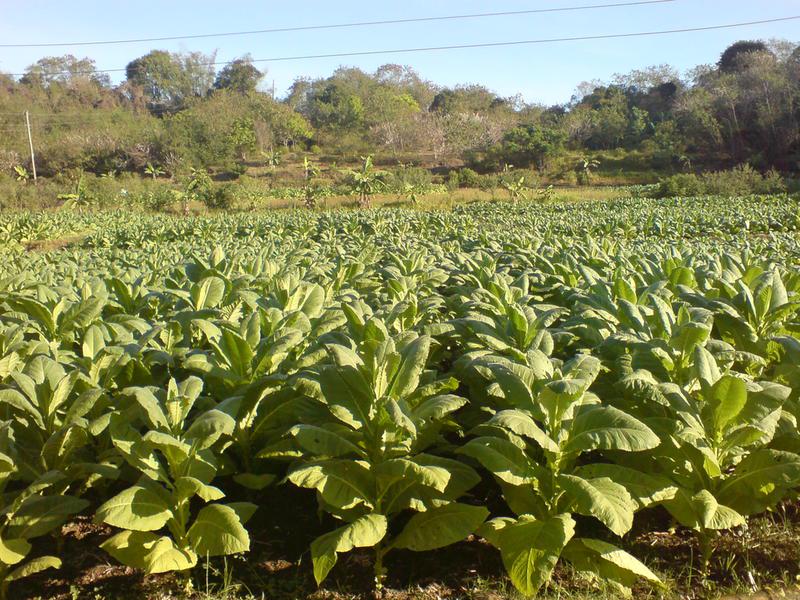Up In Smoke: The History Of Tobacco
By | January 12, 2019
Field of Tobacco. Source: (commons.wikimedia.org)
Tobacco, known scientifically as Nicotiana tabacum of the Nicotiana genus, is closely related to nightshade, a genus known for its poisonous species. Therefore, the devastating effects of tobacco use on the human body should come as no surprise. However, for years, tobacco use was not only considered safe, but it was actually considered to be medicinal.
The history of tobacco as it is known today dates back to the discovery of the New World by Christopher Columbus in 1492. Columbus was welcomed by the Native Americans with a variety of gifts, including dried tobacco leaves. The Native Americans had been smoking the leaves for years during religious ceremonies and for medical uses, and often used the leaves for bartering. However, the explorers originally thought the leaves useless and threw them overboard.
Man smoking. Source: (todayifoundout.com)
One of Columbus’s men, Rodrigo de Jerez, is thought to be the first European to develop a smoking habit. He took the habit back to Europe with him where he was arrested and imprisoned by the Spanish Inquisition, who were terrified by the sight of Jerez with smoke coming out of his mouth. However, this did not prevent the practice of smoking from spreading throughout Spain and Portugal. Sailors planted it around their trading outposts and shortly thereafter began growing it commercially in Brazil and trading it in both the Americas and Europe. Eventually, it spread as far as Queen Elizabeth’s court and reports claim that the queen herself indulged in the habit. By 1600, it was being grown in the colonies and traded worldwide.
Ceremonial Pipe. Source: (pinterest.com)
In addition to being used in Native American religious ceremonies, tobacco was thought to have medicinal properties. In 1571, Nicolas Monardes wrote a book detailing thirty-six conditions for which tobacco was thought to be a cure. A physician in 1718 claimed that tobacco “cleanses, purges, vomits, stupefies the brain, [and] resists poison.” He went so far as to say it could help with deafness. However, not everyone bought into the idea of tobacco as a cure for everything. When James I assumed the throne after the death of Queen Elizabeth, he spoke out regarding the dangers of smoking tobacco, including its damaging effects to the brain and lungs. Early 17th Century Chinese philosopher Fang Yizhi referred to the lung damage caused by smoking as “scorched lungs.” And in 1610, Sir Francis Bacon warned against the addictiveness of the smoking habit.
Pipe Tobacco. Source: (wikipedia.org)
Nevertheless, the popularity of tobacco continued to flourish, particularly in the United States after the Revolutionary War. Tobacco was such a valued commodity that it was used as collateral for the loans received from France during the war. Early users preferred chewing tobacco, which was created by mixing molasses with the tobacco leaves. R.J. Reynolds Tobacco Company, established in 1875, was limited to the production of chewing tobacco. However, the habit of smoking the tobacco in cigarettes eventually spread from Europe to the U.S.
Bonsack Rolling Machine. Source: (commons.wikimedia.org)
Philip Morris was established in the United Kingdom in 1847. They became the first company to sell hand-rolled Turkish cigarettes. In 1849, the American company J.E. Liggett and Brother was established and began selling the cigarettes. But the event which led to the widespread popularity of cigarettes was the invention of the cigarette-rolling machine by James Bonsack in 1881. He founded the American Tobacco Company which continues today as part of the global company, British American Tobacco. The tobacco industry continued to boom during both World Wars, during which cigarettes were sent to the soldiers, often included in their rations. They were heavily marketed to women during the 1920s, with the number of female smokers tripling by 1935.
Surgeon General’s Warning. Source: (thedoctorschannel.com)
As the popularity of smoking expanded, so did the investigations into the related health risks. As early as 1761, German doctors were warning of the danger of lip cancer resulting from pipe smoking. In the 1930s, the association of smoking with lung cancer was noticed by American doctors. In 1964, the surgeon general’s report acknowledged that smoking caused lung cancer in men. The result of these health findings led to numerous lawsuits against tobacco companies, forcing them to include warning labels on their products regarding the health risks of smoking. They also established limits on the marketing of tobacco products.
Man using e-cigarette. Source: (commons.wikimedia.org)
While tobacco companies continue to prosper today, with an estimated one billion tobacco users worldwide, the number of Americans who smoke has been decreasing for the past fifty years. This decrease is most likely due to the now widespread knowledge of the dangers of tobacco use. However, a new trend has begun. Vaping, which uses liquids laced with nicotine extracted from tobacco, has replaced cigarette use for many people. While thought to be safer than smoking cigarettes, these e-cigarettes still contain dangerous chemicals which lead to life-threatening medical conditions.








